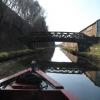
There is a bridge here which takes pedestrian traffic over the canal.
| Ocker Hill East Pipe Bridge | 3½ furlongs | |
| Site of Infilled Danks Branch Canal Crossing | 3¼ furlongs | |
| Gold Hill Bridge | 3 furlongs | |
| Gold Hill Railway Bridge | 3 furlongs | |
| Gold Hill Wharf | 1¼ furlongs | |
| Jones Bridge | ||
| Railway Bridge - West Bromwich to Wednesbury | ½ furlongs | |
| Holloway Bank Basin Bridge | 1 furlong | |
| Holloway Bank Bridge | 1½ furlongs | |
| Site of Holloway Wharf and Basins | 2 furlongs | |
| Site of Burrs Colliery Basin | 3 furlongs | |
Amenities nearby at Railway Bridge - West Bromwich to Wednesbury
- Birmingham Canal Walks — associated with Birmingham Canal Navigations
- Sixteen walks along the Birmingham Canal Navigations with a detailed description, history and photographs.
- Tame Valley Canal Walk — associated with Birmingham Canal Navigations (Tame Valley Canal)
- A walk along the Tame Valley Canal from Salford Junction to Tame Valley Junction with the Walsall Canal
Mouseover for more information or show routes to facility
Nearest water point
In the direction of Salford Junction (north)
In the direction of Tame Valley Junction
Nearest rubbish disposal
In the direction of Salford Junction (north)
In the direction of Tame Valley Junction
Nearest chemical toilet disposal
In the direction of Salford Junction (north)
In the direction of Tame Valley Junction
Nearest place to turn
In the direction of Salford Junction (north)
In the direction of Tame Valley Junction
Nearest self-operated pump-out
In the direction of Salford Junction (north)
In the direction of Tame Valley Junction
Nearest boatyard pump-out
In the direction of Salford Junction (north)
In the direction of Tame Valley Junction
Wikipedia has a page about Jones Bridge
The William A. Jones Memorial Bridge, commonly known as the Jones Bridge, is an arched girder bridge that spans the Pasig River in the City of Manila, Philippines. It is named after the United States legislator William Atkinson Jones, who served as the chairman of the U.S. Insular Affairs House Committee which had previously exercised jurisdiction over the Philippines and the principal author of the Jones Law that gave the country legislative autonomy from the United States. Built to replace the historic Puente de España (Bridge of Spain) in the 1910s, the bridge connects Quintin Paredes Road at the Binondo district to Padre Burgos Avenue at the Ermita district.
Originally designed by Filipino architect Juan M. Arellano using Neoclassical architecture, the first incarnation of the bridge features three arches resting on two heavy piers, adorned by faux-stone and concrete ornaments, as well as four sculptures on concrete plinths allegorically representing motherhood and nationhood. The original bridge was destroyed during the World War II by retreating Japanese troops and was reconstructed in 1946 by the U.S. and Philippine public works. The reconstructed bridge retained the three arches and two piers but removed all of the ornaments. The bridge was first partially restored in 1998. In 2019, the City Government of Manila began a rehabilitation project to "restore" the Jones Bridge to its near-original design using Beaux-Arts architecture similar to that of Pont Alexandre III in Paris and the return of the three original sculptures.
































